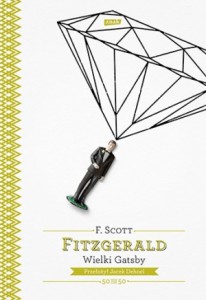April 21, 2014
“The more the better”: On multiple translations
by Emma Aylor

The cover of Dehnel’s new translation
Last week, Asymptote published the translator’s note to Jacek Dehnel’s new Polish edition of The Great Gatsby. The note, itself translated by Asymptote Slovakia’s Julia Sherwood, focuses on the translation that until recently had been the only one available in Polish: Ariadna Demkowska’s, first published fifty years ago. Dehnel writes:
The issue is not, as in the case of many translations going back several decades, one of outdated language; in that respect Demkowska’s version holds up rather well . . ., and is still a fluent and enjoyable read. As you might expect from the good old Polish school of translation.
Despite these successes, Dehnel pinpoints two aspects in which Demkowska fell short. First, the political circumstances and their attendant isolation:
. . . we have to bear in mind that Demkowska was working under very different circumstances: behind the Iron Curtain and without access to Google. It was, therefore, more difficult for her to track down various details, such as those concerning well-known financiers or popular culture starlets of the 1920s. Sometimes . . . she simply omits a detail: a girl “moving her hands like Frisco” (JD: ‘dziewczyna wymachująca rękoma jak Frisco”) simply “waves her arms” (AD: “wywija rękoma”).
Second, Dehnel writes, is a common issue with translators of the past:
. . . Demkowska tended to “normalize” the text. She flattened images she thought “too fancy” and deleted lexical and orthographical idiosyncrasies . . . Instead of Fitzgerald’s many lists, whose items he separates by a serial conjunction and” (as many as six in the description of the orchestra) and that are just as eccentric in English as in Polish, she gives a tidy list divided by commas, with a single and final “and.” . . .
Demkowska apparently regarded some similes or comments as too bold or inappropriate. A jealous woman who appears at a party at the side of her flirting husband like an “angry diamond and hissed” (JD: “jak syczący diament” – “like a hissing diamond”) simply hisses “like a snake” (AD: “syczy jak żmija”).
Dehnel’s valid criticisms sound like many of those leveled against the last century’s translator to the stars, Constance Garnett, whose translations rendered a vague, Victorian voice often referred to as “Tolstoyevsky.” As Joseph Brodsky said, “The reason English-speaking readers can barely tell the difference between Tolstoy and Dostoevsky is that they aren’t reading the prose of either one. They’re reading Constance Garnett.”
Dehnel’s motive for translation, then, is admirable:
. . . it seems to me that after living with a conventional translation for half a century it is worth re-reading Fitzgerald’s work in its wilder, slightly less easily accessible form . . ., one that is full of allusions and linguistic oddities; in a word: a work distinguished by a unique style which has assured The Great Gatsby a firm place in American and world literature.
It seems to me that Lydia Davis had it right in her Paris Review piece “Some Notes on Translation and on Madame Bovary”:
Even though a superlative translation can achieve timelessness, that doesn’t mean other translators shouldn’t attempt other versions. The more the better, in the end.
Emma Aylor is a former Melville House intern.